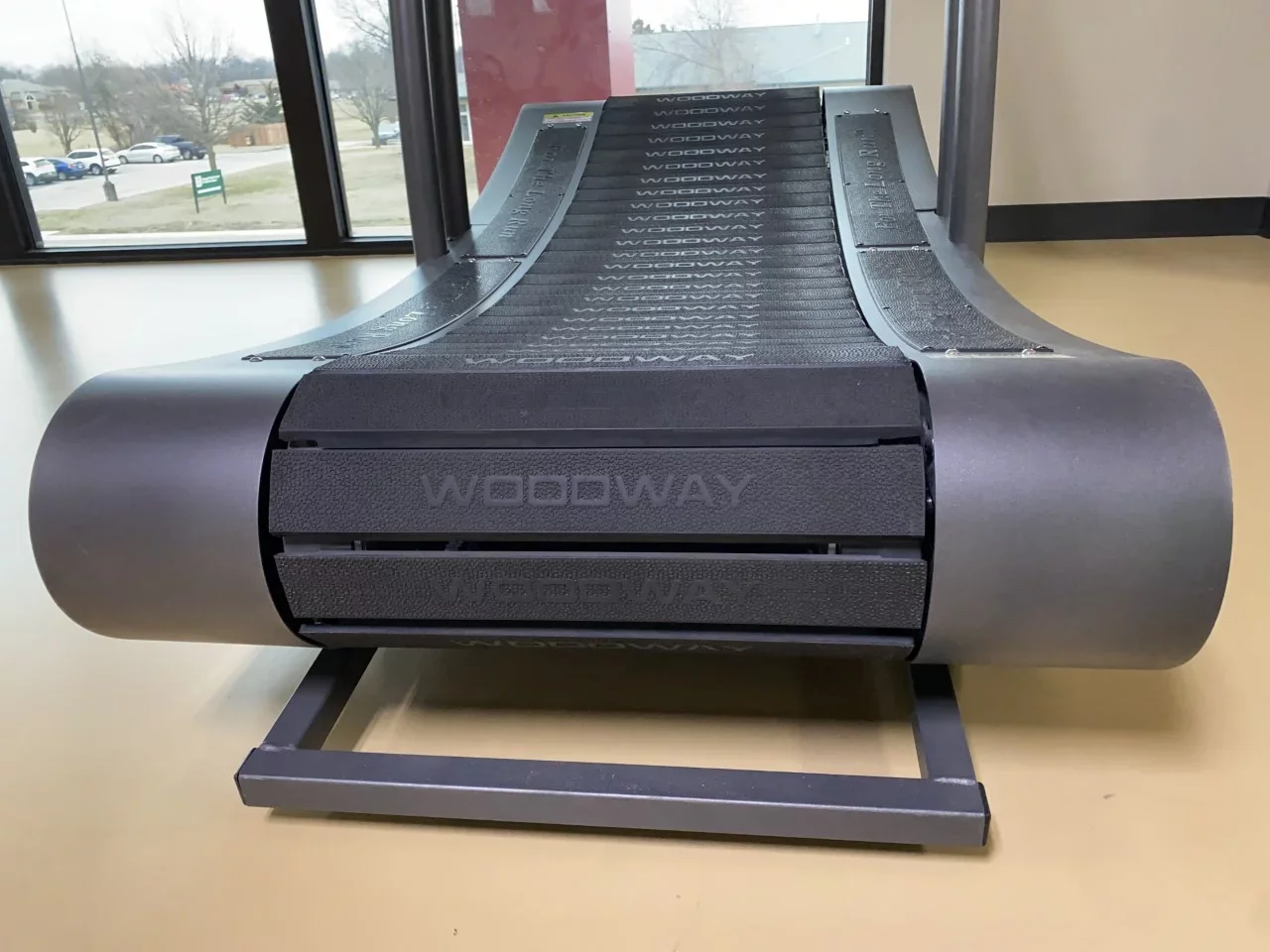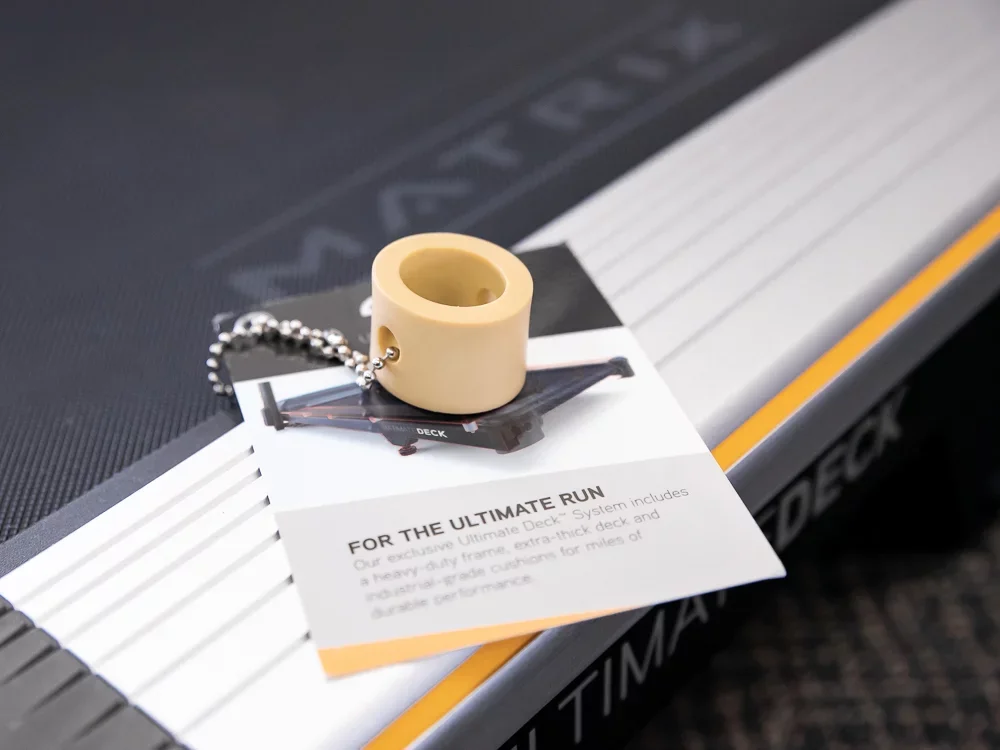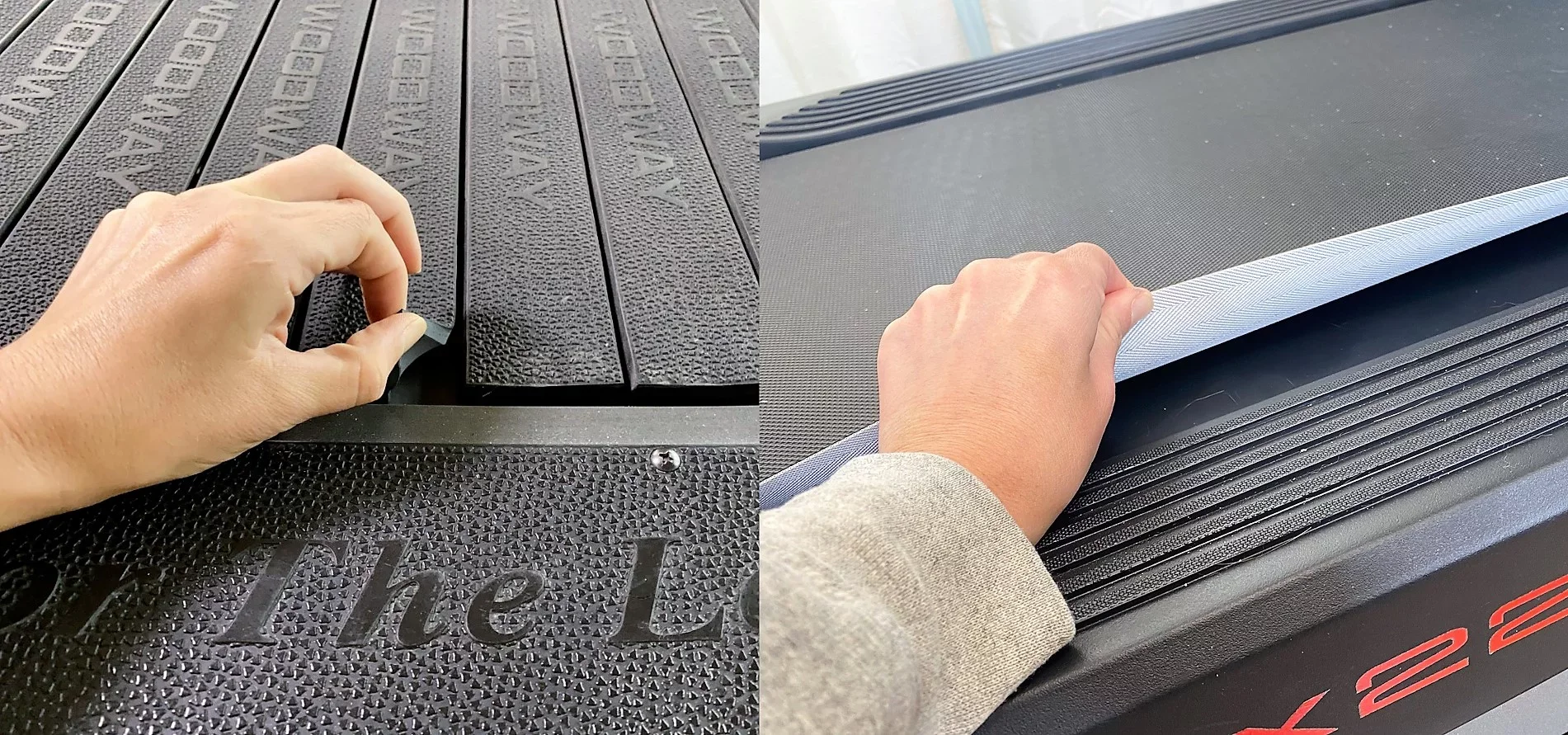Slat Belt vs. Traditional Belt- What’s the Difference?
Unlike a traditional treadmill belt that’s supported by a deck, rubber slat belts are thicker for improved cushioning. They rely heavily (sometimes entirely) on the user’s motion to move. Is a slat or traditional belt right for you? Keep reading to learn the differences, understand maintenance expectations, and decide which is best.
What’s the Difference Between a Slatted vs. Standard Treadmill Belt?
Slat Belt Treadmill Design
Slat belt treadmills are made with the knees in mind. Especially if you suffer with issues like tendonitis or arthritis, the repetitive pounding of your feet against the belt can take a toll on your joints. Slat belts are made of thick rubber for a softer landing area and typically have fewer springs beneath them.

Non-motorized slat belt treadmills like those manufactured by Woodway can substantially increase calorie burn since the user’s feet set it in motion. Photo by: Jessica Jones / TreadmillReviews.net
Some slat belts like the Sole ST90 work in tandem with a motor. Others like the Assault AirRunner are curved to allow for a motorless experience. In the latter case, belt movement is completely reliant on the movement of the runner, amping up calorie burn and working the muscles harder than you would on a motorized treadmill. Due to the upward lift of the curve, runners naturally manage better posture to maintain position and stability, preventing the forward lean many runners inadvertently assume when running on a flat surface. Furthermore, the accelerated positioning requires a higher knee drive, producing a more aggressive footstrike and efficient stride.
Whether motorized or not, the slatted design naturally produces impact-reducing qualities without having to introduce special cushioning features that can wear out over time.
Traditional Treadmill Belt Design
A regular treadmill belt is typically more familiar, because they’ve been around longer. They’re built with a hard underlying surface called the deck that supports the belt. Since there’s little to buffer the belt from the hard surface of the deck, standard treadmill belts typically have to take special measures to improve cushioning. Springs and small rubber knobs are commonly placed on the deck to cushion the blow of each footstrike.

Traditional treadmills rely on cushioning systems that use components like springs or the knob pictured to cushion the blow of each footstrike. Photo by Photo by: Oleksandr Kosheliev / TreadmilReviews.net
Regular treadmill belts have evolved over the years. Most commonly, they’re composed of a thin top layer made of rubber supplemented by an undercoating of cotton, urethane, or polyester. This 2-ply design is industry standard, because it keeps the belt running cool and provides ideal durability expectations. The motor-powered treadmill belt moves across rollers that are typically located at the front and rear ends of the treadmill deck.
To learn more and see images of the components that make up a treadmill deck, check out our article Treadmill Decks and Belts Explained.
Maintenance Requirements
Lubrication
Many treadmill belts require regular lubrication. This reduces friction to keep maintenance needs low and lengthen the lifespan of the belt. Slat belts, due to their deckless design, don’t allow you to lift the belt to lubricate the area between the belt and deck. It’s typically necessary to remove the protective panels to access the area beneath the slat belt for lubrication, so it is a more involved process.
The good news is you won’t need to lubricate your slat belt treadmill nearly as often as a traditional belt. Bearings are typically pre-lubricated, and you only need to grease the bearings on the front and rear shafts annually. A small amount of lubricant may be applied to the side of the belt if you begin to notice squeaking when in use.
Tension and Alignment
It’s critical your treadmill belt isn’t too loose or tight. Maintaining that happy medium tension on a traditional treadmill belt can dictate how long it lasts. Since motorless slat belts don’t roll over a deck and are made of large rubber pieces of material that are locked in place, tension and alignment remain calibrated.
Replacement
Since traditional treadmill belts typically require more maintenance, they pose a bigger risk of wearing down before the treadmill itself has reached the end of its lifespan. The good news is you can purchase new treadmill belts from the manufacturer and replace them yourself.
Although slats can be replaced, the process is more involved, and you’ll likely need to schedule for a certified technician to perform the job. Specialized steps like tensioning calibration and individual slat assessment are important to ensure even wear across the entire surface.
Cleaning
Whether you own a slat belt or traditional treadmill, keeping it clean is a key component in good durability. Every treadmill has its own unique cleaning suggestions. Non-motorized slat belts take longer to clean since you have to manually move the belt to clean the entire surface area.
Which is Better?

A slat belt like the Woodway EcoMill on the left consists of multiple strips of thick, shock-absorbing rubber that’s propelled by the user’s movement. The NordicTrack X22i traditional belt on the right is a single piece of 2-ply material supported by a deck that wraps around rollers. Photo by: Jessica Jones / TreadmillReviews.net
A slat treadmill belt can be a better option if you have joint issues or limitations due to past injury that requires additional cushioning beyond what added cushioning systems bring to the table. Slatted treadmills are typically more expensive, so be prepared to pay more (in some cases significantly more) than you’d spend on a traditional belt treadmill.
With that higher cost comes notably higher durability expectations. Home treadmills typically log anywhere between 1,000-1,500 miles per year, and most motorized treadmills, when properly maintained, can last 10 years before they start to encounter mechanical problems. Slat treadmills are known to last much longer. The Matrix Performance Plus is advertised as being able to last 100,000 miles. The price is about three times that of a quality motorized treadmill, but it is likely to last ten times as long.
Because many slatted belts are non-motorized, you lose the ability to take advantage of certain technical features like remote trainer controls increasingly being included in immersive tech packages. On the plus side, rubber slats can encourage proper muscle recruitment to naturally improve form while increasing effort since your legs power the belt instead of a motor.
Do Your Research Before You Buy
For most running enthusiasts, a traditional treadmill belt is preferred. Not only do they simulate more realistic training conditions, they’re typically less expensive and include more bells and whistles. Slatted belts, on the other hand, feature advanced cushioning, superior durability, posture-enhancing qualities, and enhanced lower-body strengthening capabilities. Now that you understand the differences, it’s up to you to apply them to your unique needs and fitness goals. To learn much more about all the ins and outs of treadmill shopping, check out our free Five-Step Treadmill Buyer’s Guide.
Other Treadmill Reviews:
- Test HomePage
- NordicTrack Commercial X14i
- Echelon Stride
- NordicTrack C 590 Pro
- NordicTrack T 7.5 S - Pros & Cons (2024)
- Sole TD80 Treadmill Desk
- NordicTrack Commercial X11i
- NordicTrack T 8.5 S - Pros & Cons (2024)
- Horizon Elite T5
- Exerpeutic TF1000
- NordicTrack T 6.5 S - Pros & Cons (2024)
- ProForm Sport 5.0
- ProForm Premier 900
- ProForm ZT6
- NordicTrack FreeStride Trainer FS5i (Discontinued)
- Bowflex Max Trainer M5
- BowFlex TreadClimber TC100
- ProForm Power 795
- ProForm Sport 7.0
- NordicTrack Incline Trainer X15i
- NordicTrack C 1650 Treadmill
- Horizon Elite T9
- Official Boston Marathon Treadmill 4.0
- NordicTrack Treadmill Desk
- NordicTrack C 1630 Pro
- NordicTrack C 970 PRO
- Bowflex TC20 TreadClimber

